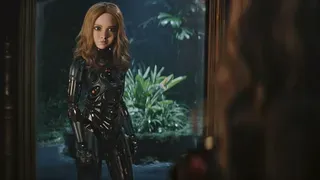June 14, 2013
Man of Steel
Kilian Melloy READ TIME: 8 MIN.
If the Superman at the center of "Man of Steel" suffers an identity crisis, it's hardly surprising. The thing is, it's not so much because he's the lone survivor of an extinct alien race who's been raised among human beings; and it's not because he's the only son of two very different fathers, a bold scientific visionary from the planet Krypton versus a cautious, pragmatic farmer from Earth. This Superman seems befuddled mostly because he spends more of his time skulking and fretting than enjoying his amazing abilities of free flight, super-strength, and outrageously keen senses. The poor guy has Superman's costume, but Batman's existential angst.
Zack Snyder may have brought his fantastic visual aesthetic to "Man of Steel," but in tone and pacing the film is heavily smudged with the fingerprints of "Batman Begins" and "Dark Knight" writer-director Christopher Nolan, who produced and, with David S. Goyer, concocted the story. (Goyer wrote the screenplay.) Like Nolan's Batman trilogy, this new Superman opus goes big, goes dark, and forsakes camp (and humor) for knuckle-gnawing anxiety, all while allowing old-school cinematic virtues to lapse into video game kineticism with over-the-top, CGI-reliant action.
Bryan Singer's 2006 chapter, "Superman Returns," was meant to fit in loosely with the Christopher Reeve-era "Superman" films (if you squint, you can just about make Singer's take, starring Brandon Routh, work as a fifth movie in that series). By contrast, Snyder's "Man of Steel" is a different animal completely, hitting the reset button with a new telling of Superman's origins.
Gone is the crystalline Krypton, with its quartz-like spires and barren, arctic landscape. In its place we see an ancient world where even the stone of its cities, mounts, and valleys looks like it's slipped into decline. This is a worn and depleted planet well past its prime; its tech looks heavy and leaden, and its citizens as rough-hewn as world's rocky environs. Among them are Jor-El (Russell Crowe), the planet's most brilliant scientist, and his beautiful, even exotic, wife Lara (Ayelet Zurer). They know that Krypton is in its final days; a project to mine the planet's core has created a chain reaction that will blow their world apart.
As in Richard Donner's 1978 "Superman," Jor-El faces off with Krypton's military leader, General Zod, who leads an attempted coup against a feckless government. As envisioned by writer Mario Puzo in Donner's version, Zod was a megalomaniac; Terence Stamp played him with rage and verve, and made Zod the best part of the first sequel, the cartoonish "Superman II." But this being a Superman origin story for Millennial moviegoers, Zod needs to be meaner, less flamboyant, and more realistically motivated. That, as much as anything, must have informed the casting choice for the part: Zod is played here by Michael Shannon, whose roles often call on him to tap into a vein of righteous dementia. In this case, it's a matter of genetic destiny; it's literally programmed into Zod's DNA that he should be a militaristic madman. His insurrection clashes with Jor-El's scientific way of thinking, and the two men become embroiled in a blood feud, much as in the 1978 film, though in this case Jor-El is much more of an action hero than Marlon Brando's aristocratic Jor-El was in the Donner film.
Zod's punishment, like his crime, is familiar: Exile from Krypton in the folds of the "Phantom Zone," which in this telling entails cryogenic suspension in an orbiting penal satellite. Familiar, too, is Jor-El's attempt to preserve a fragment of Krypton by sending his son to Earth, where he will grow up looking like a human being but possessing godlike powers. The Superman mythos has always been a frank Christian allegory, but Nolan and Goyer don't play it up to the degree that Singer did; Jor-El intends his son to be a mentor to humanity, but maybe not quite the savior that Singer's Superman tried to be.
What this Superman, played by Henry Cavill, does do is give us an impression of power. Cavill has bulked up since his "Tudors" days, and when we catch sight of him shirtless, in tattered trousers, he almost looks like he belongs in yet another comic book movie, something more to do with The Incredible Hulk. The way Clark lives, wandering around under assumed names, taking low-level jobs, and practicing random acts of super-powered kindness, fits into that setting as well. Where's Clark the bumbling young reporter? Where's dishy Lois Lane?
It takes a while to get the gist of who Clark is, and why he seems so tightly wound. Don't worry, though: High powered reporter and love interest Lois Lane (Amy Adams, doing her best with an under-developed character) isn't long in showing up, and when Clark eventually makes his way to the frozen far north, where he discovers his true (if alien) identity, the film rapidly re-orients itself to more familiar territory. Unfortunately, though, "Man of Steel" never loses its glumness. Even when Superman learns to fly, "Man of Steel" remains pinned by the script's all too oppressive gravity.
Tonally, this film is a far cry from the previous "Superman" movies, but it's littered with winks to those earlier outings, especially the first two movies (which had initially been intended as two halves of a larger, more integrated, whole than was eventually the case). Cue the father-son speeches (Kevin Costner's Jonathan Kent, like Glenn Ford's earthly father figure before him, counsels that Clark must be on Earth "for a reason"); cue the city-trashing super-throwdown. A couple of them, actually.
These furious dust-ups take place between Supes, Zod, and Zod's female lieutenant, Faora-Ul (Antje Traue), who may not be named Ursa (as was Zod's female accomplice in the 1980 Richard Lester movie), but who could easily have slipped into Ursa actress Sarah Douglas' leather kit. The U.S. military also steps in with jet fighters and missiles, trying (and failing) to kill off every Kryptonian in sight, including the guy with the big red "S." (Whoops, pardon, I forget: "It's not an 'S'... it means 'hope.' ") The battles royale radically expand on the fisticuffs of "Superman II" thanks to modern movie magic and loads of CGI, but there is such a thing as too much: The fights drag on and on, with plenty of noise and falling skyscrapers, but little sense of panic, urgency, or even much dismay. (Civilians simply retreat inside and lock their doors, for all the good that will do them when a heavily armored alien, an SUV, or a locomotive comes crashing through the roof.)
For all the ways it finds to pay homage, though, this is a movie that marks out its own (somewhat arid) turf. There's no turning the earth back, no poisonous green Kryptonite crystals, no Jimmy Olson, and no Lex Luthor (though we catch a glimpse of a "Lex Corp" logo on a tanker truck just before it explodes in flames).
There is, mind you, a super-scream of grief and fury. In this case, however, set as it is in a film that's big and anxious and more than a little bit plodding, that scream isn't the cry of anguish it was in the 1978 movie, with its literal and figurative flights of fancy, its frequent splashes of color and humor, and its breezy, pulpy charm. That was a scream of heartbreak; this time around, Superman's cri de coeur comes from a fundamental existential crisis: Does he choose to side with Zod, who has tracked him across the universe to propose an Earth-destroying plan for the resurrection of Krypton? Or does he choose Earth, a planet full of arguably lesser beings who are apt to distrust and fear him? Where, and among whom, does he belong?
Only late in the game does "Man of Steel" feel like it's actually arrived at its own source material. When Superman finally dons a pair of goofy eyeglasses (the only disguise he's ever needed to pass as a human being), Cavill finally seems to channel Reeve's charm - and it's at that moment you realize what this film has been missing all along. This is a big move, epic in scope and flawless in its production, but it's just no fun.
You really will believe a man can fly (and move faster than the eye can follow, and roast his enemies with heat vision). You just won't connect much with any of the characters because they, like this production, are larger than life, but essentially hollow.
Kilian Melloy serves as EDGE Media Network's Associate Arts Editor and Staff Contributor. His professional memberships include the National Lesbian & Gay Journalists Association, the Boston Online Film Critics Association, The Gay and Lesbian Entertainment Critics Association, and the Boston Theater Critics Association's Elliot Norton Awards Committee.




